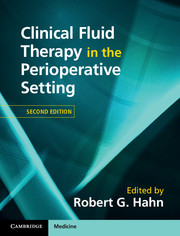Book contents
- Clinical Fluid Therapy in the Perioperative SettingSecond Edition
- Clinical Fluid Therapy in the Perioperative Setting
- Copyright page
- Contents
- Contributors
- Preface
- Overview of chapter summaries
- Section 1 The fluids
- Section 2 Basic science
- Section 3 Techniques
- Section 4 The clinical setting
- Index
- References
Section 4 - The clinical setting
Published online by Cambridge University Press: 05 June 2016
- Clinical Fluid Therapy in the Perioperative SettingSecond Edition
- Clinical Fluid Therapy in the Perioperative Setting
- Copyright page
- Contents
- Contributors
- Preface
- Overview of chapter summaries
- Section 1 The fluids
- Section 2 Basic science
- Section 3 Techniques
- Section 4 The clinical setting
- Index
- References
- Type
- Chapter
- Information
- Clinical Fluid Therapy in the Perioperative Setting , pp. 141 - 269Publisher: Cambridge University PressPrint publication year: 2016



